October 2014
Saws and Saw Blades
Need to Know: Gas-Powered Saws
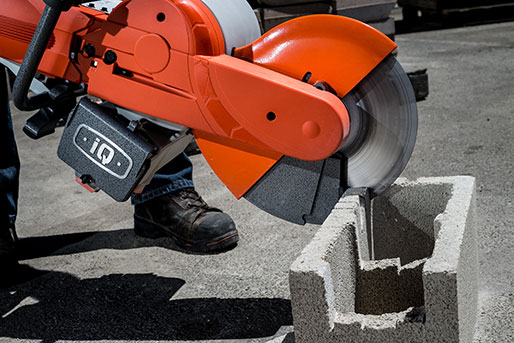
When it comes to masonry saws, many options are available on the market, from corded power saws to cordless, gas-powered models. Power tools are a major investment, and some consideration must be made prior to making such a substantial purchase. So, which saw is the best tool for your job? Masonry reached out to a number of manufacturers and retailers of gas-powered saws to get the lowdown on the latest models.
Acme Tools, headquartered in Grand Forks, N.D., is a major industrial tool distributor and retailer of tools and equipment. With 10 retail stores in North Dakota, Minnesota and Iowa, a direct-mail catalog division, and an e-commerce website, Acme Tools stocks more than 180,000 products from 3,500 manufacturers.
Among those offerings are gas-powered saws by STIHL, Husqvarna and Makita. Joel Kovar, assistant manager of Acme Tools’ Grand Forks store, says the three brands basically offer all the same type features on gas-powered masonry saws. The choice really comes down to brand preference of the purchaser.
|
|||
“Customers are looking for reliability; they want it to run when they need it to,” says Kovar. “These are all reliable brands of saws. One manufacturer might have a better air filtration system and one may start a little easier. If a customer has been using a particular brand for years with good results, that’s what they’re going to continue to buy.”
Kovar says the progression of masonry saws – during the two or three decades his company has sold them – has been toward making them lighter and more compact, yet more powerful. Many of the improvements through the years have had to do with better filtering technology.
“Air filters really have changed on the saw,” he says. “Now, probably 99 percent of the air is getting filtered before it gets into the engine. That makes a major difference in servicing and reliability.”
Other performance improvements, however, are often determined by the user. Take fuel efficiency, for example. “If you have two guys doing the exact application, one may hold the throttle wide open, while the other holds it halfway open. Both will get the job done at the same time,” he says, adding that fuel efficiency will not be the same between the two.
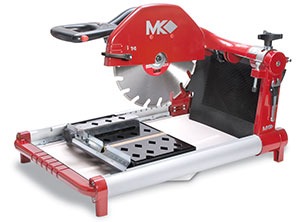
Among some of the more recent offerings at Acme Tools is STIHL’s fuel-injected saw, the TS500i. “It has better balance, easier starting, quick pull, light weight and it’s new in the industry this year,” says Kovar. The electronically controlled fuel injector means no carburetor, and no carburetor means no choke; just purge it and pull it.
While the gas-powered saw isn’t new technology, there have certainly been some improvements in the product through the years. For instance, Makita recently released what’s being billed as “the world’s first 4-stroke power cutter,” making fuel mixing a task of the past. The saw was unveiled in January 2014 at the World of Concrete/World of Masonry show, and the company has been getting a lot of feedback since.
“It’s a game changer in the industry, because you don’t have to mix fuel anymore,” says Wayne Hart with Makita, noting the convenience of not having to deal with two gas cans on the jobsite. In addition, not having to purchase oil to mix not only saves money, it eliminates the risk of maintenance and repairs due to improper fuel mixing.
“When you get to the end of the day, and you just have a couple more cuts to make, you might be tempted to put in straight gas,” says Hart. “That’ll seize the motor and mean a big repair bill.”
The gas-powered cutter can cut wet or dry, and a retractable wheel kit makes it easier to do extended cuts down a line. “Because they’re retractable, when you sit the cutter down, the wheels aren’t touching,” he says. “That keeps it from vibrating and allowing it to ‘walk’ while it’s sitting on the ground with the motor running.”
| Product Watch |
|
The 4-stroke is slightly quieter than the 2-stroke and is easier to start. In fact, the automatic engine decompression makes it 40 percent easier when pulling the starter cord than a comparable model, says Hart. Comparatively, the company’s 4-stroke price starts around $1,200, while a 2-stroke starts at $700.
Clean air is an important factor with the gas-powered cutter. The 4-stroke produces lower emissions than a 2-stroke, and Mikita’s five-stage filtration system not only keeps air cleaner, it’s designed for easy removal of accumulated dust and debris.
Likewise, Hilti features a cyclone filtration system designed for reduced maintenance and increased durability, reducing the frequency with which air filters must be changed. “It takes air in and circulates it, throws off the biggest dust particles, and brings the cleanest air to the filter, reducing the amount of dust particles going into the filter,” says David Walker, product manager of gas saws for Hilti North America.
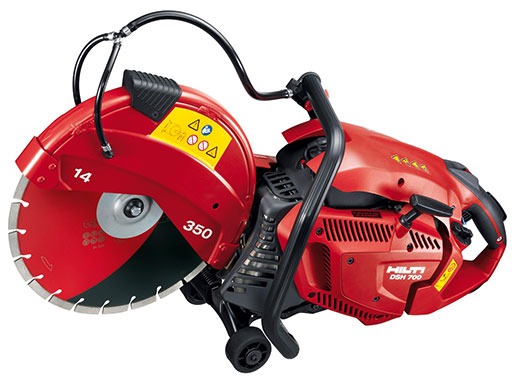
Hilti’s first generation gas-powered concrete and masonry saws were released in 2004. Several generations of saws later, Hilti markets saws featuring “the best power-to-weight ratio in its class,” with the DSH 700 and DSH 900 being the most common, says Walker. The 700 is a 70cc saw available in 12- and 14-inch models, while the 900 is a 90cc available in 14- and 16-inch models.
| Product Watch |
Hilti’s integrated choke and gas control allow users to turn the choke on with the trigger half pulled, making it easier to start with fewer rope pulls. “You don’t have to pull these 15 or 20 times, so there’s less wear and tear,” Walker says.
Easy maintenance is always a goal with product development. This latest generation of saws makes air filters easier to change than ever, says Walker. “It’s easy to get to, and the screws are integrated into the air filter housing, so they don’t drop.”
Another feature of Hilti saws is the reversible wheel design, which prevents the saw from rolling when not in use. And a three-point vibration absorbing system provides vibration transfer that improves operator comfort and productivity.
Appealing to many contractors is Hilti’s fleet program, an option for sourcing tools from Hilti without the big layout upfront to purchase them. The program is especially popular for sourcing gas-powered saws. “The nature of these tools is that they have very hard, heavy usage – a lot of dust in a rough environment,” says Walker. Instead, fleet members pay a monthly usage fee that includes repair costs and theft coverage.
Unique to gas-powered masonry saws from IQ Power Tools are a vacuum system, filter system, and dust containment system that allow the mason to operate virtually dust free, says Paul Guth, VP of product development. A 100 percent dry cut saw, the iQPC912 collects 99.5 percent of the dust, making the danger of silica exposure practically a non-issue.
Integrated into the saw, a belt drives the blade and also powers a vacuum fan that sucks dust through the blade guard and into a dust containment chamber. The chamber can hold up to 5 pounds of dust before it needs to be emptied, and the filter is rated for 100 cutting hours or 90 days.
“Other saws that use water for dust suppression require a hose or pump system. That becomes a problem with mud and staining and, in the winter, it’s almost impossible,” says Guth, a third-generation mason who opened the products business a decade ago with family members who also were in the trade.
“All of our tools have come out of a masonry and concrete construction background,” he says, noting that the iQPC912 retails for $1,950. Maintenance for the IQ Power Tools masonry saw is typical for a power cutter engine – maintaining the dust collection system, changing the filter about every 90 days (depending on amount of usage), and routine changing of the spark plug and fuel filter.
In general, safety factors when using this type of equipment are fairly standard across the board. Hart urges users to first read the instruction manual as it’s the best source of information regarding all aspects of the equipment, regardless of the brand. Use of hearing and eye protection, a hard hat with face protection, gloves and respiratory protection also are essential.
At the end of the day, says Kovar, regardless of the preferred brand, customers are most interested in dependability, ease in starting, and serviceability – including easy access to serviceable parts.
K.K. Snyder is a freelance writer based in Albany, Ga.
| Product Watch |
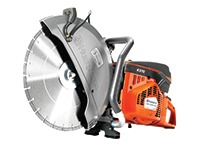 The Husqvarna K 970 power cutter has a high power output of 6.4 horsepower and a well-balanced body that make it efficient and easy to use in all handheld cutting applications. The low weight (24.2 pounds for 14 inches without fuel and cutting equipment) and optimized performance enhance the machine’s power-to-weight ratio.
The Husqvarna K 970 power cutter has a high power output of 6.4 horsepower and a well-balanced body that make it efficient and easy to use in all handheld cutting applications. The low weight (24.2 pounds for 14 inches without fuel and cutting equipment) and optimized performance enhance the machine’s power-to-weight ratio.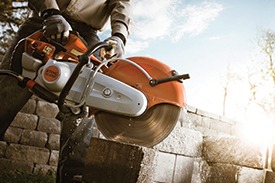 The STIHL TS 500i Cutquik 14-inch cut-off machine is powerful, lightweight and well balanced. The STIHL computer-mapped fuel injection system continuously and precisely determines fuel mixture, injection and ignition timing. The fuel injection system also makes starting easier and more reliable by eliminating the need for a choke. Just set the switch to on, prime and pull.
The STIHL TS 500i Cutquik 14-inch cut-off machine is powerful, lightweight and well balanced. The STIHL computer-mapped fuel injection system continuously and precisely determines fuel mixture, injection and ignition timing. The fuel injection system also makes starting easier and more reliable by eliminating the need for a choke. Just set the switch to on, prime and pull.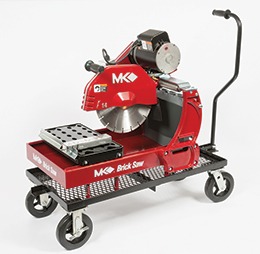
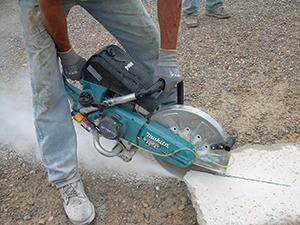 For cutting brick, block, or concrete, the Makita 4-stroke engine power cutter offers easy starts, fuel economy, and the ability to fill the tank with straight unleaded gas. With 2-stroke power cutters, engine seizure due to improper fuel and oil mixing is one of the most common failures.
For cutting brick, block, or concrete, the Makita 4-stroke engine power cutter offers easy starts, fuel economy, and the ability to fill the tank with straight unleaded gas. With 2-stroke power cutters, engine seizure due to improper fuel and oil mixing is one of the most common failures.